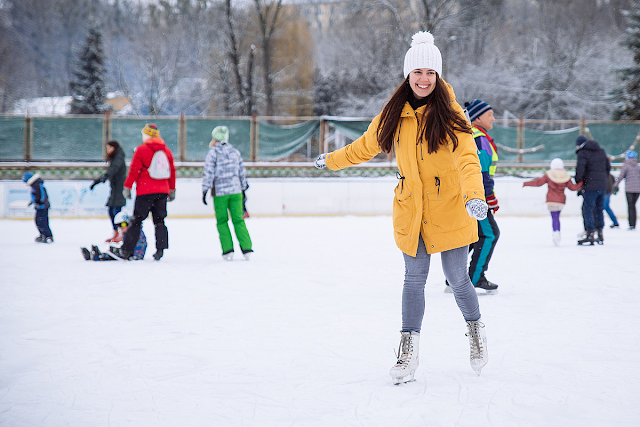Skating Locator
Outdoor Ice Skating Rinks & Arenas

Natural ice
Many ice rinks consist of, or are found on, open bodies of water such as lakes, ponds, canals, and sometimes rivers; these can only be used in the winter in climates where the surface would freeze thickly enough to support human weight. Rinks can also be made in cold climates by enclosing a level area of ground, filling it with water, and letting it freeze. Snow may even be packed to use as a containment material.
A famous example of this type of rink is the Rideau Canal Skateway in Ottawa, Ontario, Canada, estimated at 1,782,000 square feet (165,600 m2) and 7.8 kilometres (4.8 mi) long, which is equivalent to 90 Olympic size skating rinks. The rink is prepared by lowering the canal’s water level and letting the canal water freeze. The rink is then resurfaced nightly by cleaning the ice of snow and flooding it with water from below the ice. The rink is recognized as the “world’s largest naturally frozen ice rink” by the Guinness Book of World Records because “its entire length receives daily maintenance such as sweeping, ice thickness checks and there are toilet and recreational facilities along its entire length”.
The longest ice skating trail can be found in Invermere, British Columbia, Canada, on Lake Windermere Whiteway. The naturally frozen trail measures 29.98 kilometres (18.63 mi).[6]
Artificial ice
In any climate, an outdoor ice skating surface can be installed in a properly built space. This consists of a bed of sand or occasionally a slab of concrete, through (or on top of) which pipes run. The pipes carry a chilled fluid (usually either a salt brine or water with antifreeze, or in the case of smaller rinks, refrigerant) which can lower the temperature of the slab so that water placed atop will freeze. This method is known as ‘artificial ice’ to differentiate from ice rinks made by simply freezing water in a cold climate, although both types are of frozen water. A more proper technical term is ‘mechanically frozen’ ice.
Construction
Modern outdoor ice skating rinks have a specific procedure for preparing the surface. With the pipes cold, a thin layer of water is sprayed on the sand or concrete to seal and level it (or in the case of concrete, to keep it from being marked). This thin layer is painted white or pale blue for better contrast; markings necessary for hockey or curling are also placed, along with logos or other decorations. Another thin layer of water is sprayed on top of this. The ice is built up to a thickness of 3/4ths an inch to 1 1/2 inches.[7] The industry standard in the NHL is around 1 1/2″.
Synthetic
Synthetic outdoor ice skating rinks are constructed from a solid polymer material designed for skating using normal metal-bladed ice skates. High density polyethelene (HDPE) and ultra-high molecular weight polyethylene (UHMW) are the only materials that offer reasonable skating characteristics, with UHMW synthetic rinks offering the most ice-like skating but also being the most expensive. A typical synthetic rink will consist of many panels of thin surface material assembled on top of a sturdy, level and smooth sub-floor (anything from concrete to wood or even dirt or grass) to create a large outdoor ice skating area.
Operation
Periodically after the ice has been used, it is resurfaced using a machine called an ice resurfacer (sometimes colloquially referred to as a Zamboni – who are a major manufacturer of such machinery). For curling, the surface is ‘pebbled’ by allowing loose drops of cold water to fall onto the ice and freeze into rounded peaks.
Between events, especially if the outdoor ice skating arena is being used without need for the ice surface, it is either covered with a heavily insulated floor or melted by allowing the fluid in the pipes below the ice to warm.
A highly specialized form of rink is used for speed skating; this is a large oval (or ring) much like an athletic track. Because of their limited use, speed skating ovals are found in much fewer numbers than the more common hockey or curling rinks.
Those skilled at preparing outdoor ice skating arena ice are often in demand for major events where ice quality is critical. The popularity of the sport of hockey in Canada has led its icemakers to be particularly sought after. One such team of professionals was responsible for placing a loonie coin under center ice at the 2002 Winter Olympics in Salt Lake City, Utah; as both Canadian teams (men’s and women’s) won their respective hockey gold medals, the coin was christened “lucky” and is now in the possession of the Hockey Hall of Fame[8] after having been retrieved from beneath the ice.
